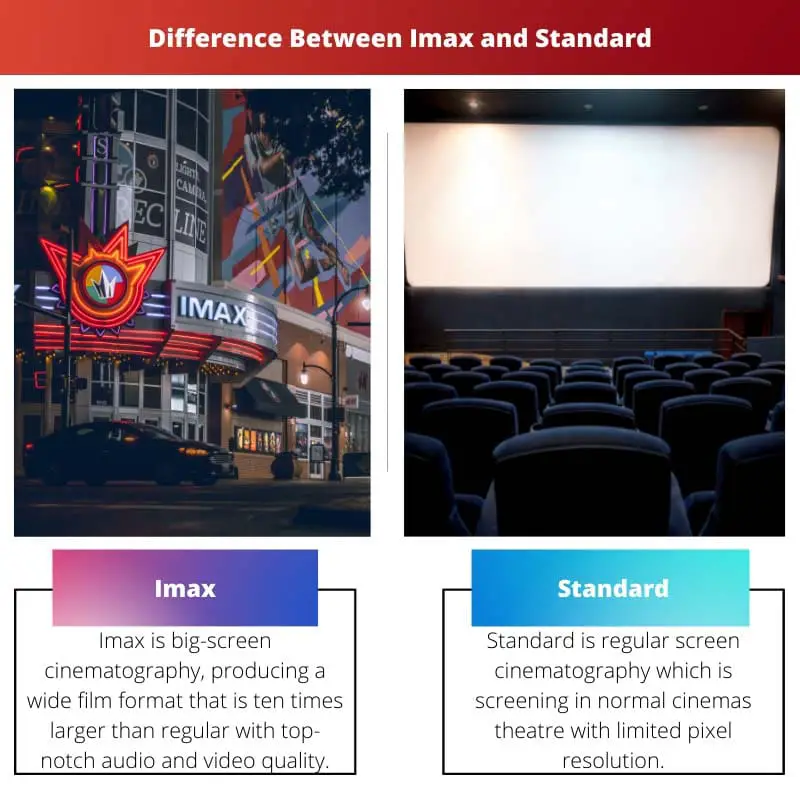Lately, everyone has begun watching movies or any entertainment stuff based on either the plot or its cinematography. And this art and technology of motion-picture photography have captured a mass number of audiences.
Starting from the lighting of the set or scene to preferences of various camera angles, lenses, filters, and special effects, both Imax, as well as Standard have done their best part in cinematography.
Key Takeaways
- IMAX theaters feature larger screens and higher resolution, offering a more immersive movie experience than standard cinemas.
- IMAX theaters utilize a unique projection system that reduces distortion, producing sharper and brighter images than standard theaters.
- IMAX sound systems deliver powerful, precise audio with a higher dynamic range, enhancing the movie experience.
Imax vs Standard
IMAX is a specialized film format that features a larger screen size and higher resolution than standard movie screens. IMAX screens are much taller and wider than standard movie screens and offer a more immersive experience for viewers. Standard movie screens are smaller and have a more rectangular aspect ratio. These screens are more common in traditional movie theatres.

Imax is big-screen cinematography, producing a wide film format that is ten times larger than regular with top-notch audio and video quality. It was initially established in 1967 by IMAX corporation to deliver its audiences a high-resolution quality video.
Besides, Imax implements its cinematography ideas in devices like cameras, laser projection, grand theatre, and stadium seating.
On the other hand, the Standard is regular screen cinematography which is screening in normal cinemas and theatres with limited pixel resolution.
It was founded around 1879 to 1965 by a French Physicist named Henri Chretien during his physics experiment.
In addition to its discovery purpose, modern techniques are using the standard as an approach to develop cinematography in televisions, cameras, and cinema screens.
Comparison Table
| Parameters of Comparison | Imax | Standard |
|---|---|---|
| Meaning | Imax is big-screen cinematography, producing a wide film format that is ten times larger than regular with top-notch audio and video quality. | Standard is regular screen cinematography which is screening in normal cinemas theatre with limited pixel resolution. |
| Launched | Imax was founded by IMAX corporation, a Canadian theatre company, on 20th August 1967 in order to facilitate a high-resolution video quality to the audiences. | The standard screen was introduced later between 1879-1965 by french Physicist Henri Chretien. |
| Screen ratio | IMAX is developed as high-resolution video quality with an approximate ratio of either 1.43:1 or 1.90:1. Imax is a dome circular and big screen which occupies the entire theatre with its big screen. Besides, Imax is six times bigger than a regular screen. | Standard is prevalent with an aspect ratio of 16:9 for its ultrawide displays. Besides, Standard comes with two ratios that are applied for PCs like 3:2. |
| Varieties | Imax has launched various varieties with high-resolution cameras, laser projection technology, Grand Theater, GT 3D, Small Rotor, and MPX under theatre and stadium seating. | Standard developed as a standard display which has launched in various products such as cameras, television, theatre screens, etc. |
| Picture quality | Imax follows three types of projection formats in the products such as 15 Perforation, IMAX 4K with laser, IMAX 2K Digital, and 70mm film system. | Standard comes with a film format of 35 mm on a rectangular screen, while the view is square. |
What is Imax?
Imax is big-screen cinematography, which produces a wide film format that is ten times larger than regular with top-notch audio and video quality. Over and above, the Imax was developed as high-resolution video quality with a 70 mm film format.
It was initially established in 1967 by IMAX Corporation, a Canadian technology company.
Imax was invented to deliver its audiences a high-resolution quality video. The Imax is structured with a ratio that is measured as either 1.43:1 or 1.90:1 in the displays and is six times bigger than the regular screen ratio.
Imax is a dome circular and big screen which occupies the entire theatre with its big screen.
Subsequently, Imax has launched various varieties starting from high-resolution cameras, laser projection technology, grand theatre, GT 3D, Small Rotor and MPX under theatre and stadium seating.
Following its picture quality, Imax has three types of projection formats in their products such as 15 Perforation, IMAX 4K with laser, IMAX 2K Digital, and 70mm film system.
In the abstract, Imax contributes a major part to the movies that we see on big screens, especially for its high-resolution cinematography that has a 70mm film system, 15 Perforation, IMAX 4K with laser, and IMAX provides 2K Digital cameras.

What is Standard?
Owning a home projector or home theatre has always been everyone’s dream since Standard’s establishment. In that case, the Standard is regular screen cinematography which is screening in normal cinemas and theatres with limited pixel resolution.
It was founded around the 1920s by a French Physicist named Henri Chretien during his physics experiment.
In addition to its original discovery purpose, modern techniques are using the Standard idea as an approach to develop cinematography in televisions, cameras, and cinema screens.
Speaking of its display dimension, Standard has gained popularity in its ratio of 16:9 for its ultrawide displays. Alongside, it comes with two ratios that are applied for PCs like 3:2. Standard comes with a film format of 35 mm on a rectangular screen, while the view is square.
On the whole, the standard has a 35 mm film format system and with limited pixel resolution, which is popular across the entertainment field, especially works well on PCs, theatres, or television.
However, Standard is not better than high-definition movies, but still, it is great for downloading and streaming video using less amount of data.

Main Differences Between Imax and Standard
- Imax is a high-resolution screen display, whereas Standard is a regular resolution audio-visual quality.
- Imax was developed in 1967 by a Canadian technology company. Meanwhile, Standard was launched in the 1920s by French Physicist Henri Chretien.
- The Imax ratio is measured as either 1.43:1 or 1.90:1 in the displays and is six times bigger than the regular screen ratio. Albeit, Standard comes with a 16:9 ratio on the big screen and 3:2 on PC displays.
- Imax developed its feature in various products like- cameras, laser projection, Grand theatre and stadium seating. Notwithstanding, the Standard applies to television, cameras and cinemas, screens etc.
- When it comes to picture quality in theatre, The Imax was developed as high-resolution video quality with 70 mm film format, but Standard follows the film format of 35 mm.



